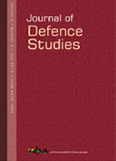Revolution in Military Affairs with Chinese Characteristics
While China’s interest in Revolution in Military Affairs (RMA) dates back to the mid-1980s, the Western hi-tech precision military action in the 1991 Gulf War; the 1999 Kosovo war; the 2003 Iraq war and the continuing Afghan campaign have all convinced it to opt for the RMA, albeit within the limits of Chinese technology, organisation, and defence budget.
- Srikanth Kondapalli
- July 2011











